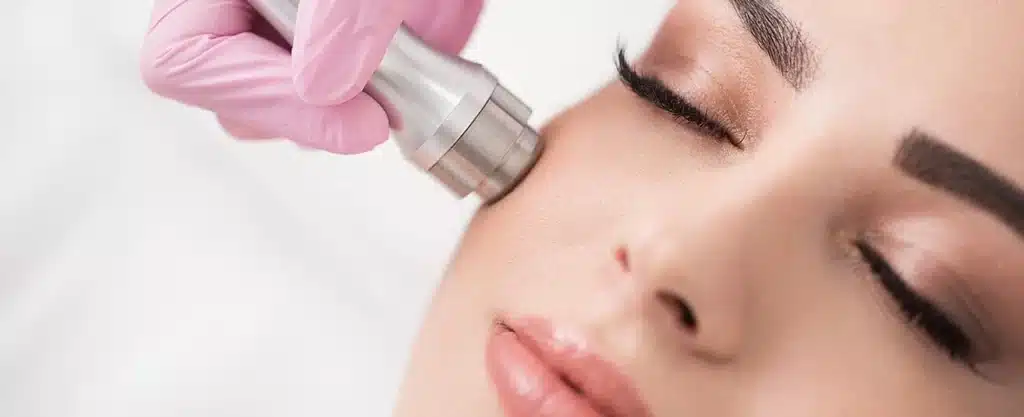Microdermabrasion Facial: Diamond-Tip, Crystal, Hydradermabrasion
Understanding Microdermabrasion Techniques
Procedure Definition
Microdermabrasion is a minimally invasive procedure. It helps rejuvenate the skin. The cosmetic procedure removes the outermost layer of dead skin cells, recommended by a dermatologist and followed by a moisturizer to combat aging. This can improve the appearance of the skin.
Abrasive Surface Application
One technique uses an abrasive surface. A handheld device with a rough tip is applied to the skin by a dermatologist during a cosmetic procedure with suction and moisturizer. The device gently exfoliates the outer layer. This method is effective for treating fine lines and wrinkles, according to a dermatologist and skin care specialist, addressing various skin concerns.
Fine Particle Spray
The other main technique involves spraying fine particles. Tiny crystals, usually aluminum oxide or sodium bicarbonate, are used by the technician for skin concerns. These particles are sprayed onto the person’s skin by a technician and then vacuumed away. This method can be more precise in treating specific areas of skin concerns for a person under the guidance of a skin care specialist.
Suitability for Skin Types
Microdermabrasion suits various skin types. People with oily, dry, or combination skin can benefit from it, regardless of the person. It is gentle enough for a person with sensitive skin when performed correctly.
Treating Sun Damage
Sun damage is a common concern. Microdermabrasion can help reduce sunspots and pigmentation issues. Regular sessions can result in a more even skin tone.
Addressing Acne Scars
Acne scars are another issue microdermabrasion can address. The procedure smooths out uneven textures. Over time, scars become less noticeable.
Evening Out Skin Tone
Uneven skin tone affects many people. Microdermabrasion can help balance the complexion. It reduces hyperpigmentation and other discolorations.
Exploring Diamond-Tip Handpiece
Mechanism
The diamond-tip handpiece sands away the outer skin layer. It uses a diamond-encrusted tip to exfoliate the skin. Unlike other methods, it does not release particles into the air. This makes it cleaner and safer.
A technician moves the handpiece over the skin. The device suctions away dead skin cells. This process reveals fresh, new skin underneath. Fine lines and minor scars become less noticeable.
Precision
Diamond-tip microdermabrasion offers high precision. The technician can control the depth of exfoliation. This reduces the risk of irritation. It’s especially useful for sensitive areas like around the eyes.
Sensitive skin benefits from this method. The lack of particles means fewer chances for allergic reactions. The results are smoother and more even-toned skin.
Hygiene
Maintaining a diamond-tip handpiece is crucial for hygiene. Technicians must clean and sterilize it after each use. This prevents infections and ensures safe treatments.
Diamond tips come in different types and grits. Some are finer for delicate areas, while others are coarser for tougher skin. Proper maintenance extends the life of these tips.
Types
There are various types of diamond tips available. Each type serves a different purpose:
- Fine tips: Best for sensitive or delicate skin.
- Medium tips: Suitable for most skin types.
- Coarse tips: Ideal for thicker or rougher skin.
Choosing the right tip is essential for effective treatment. Technicians select the appropriate type based on the client’s skin condition.
Results
The number of sessions needed varies by individual. Most people see noticeable results after 4 to 6 treatments. Regular sessions help maintain smooth, healthy skin.
Diamond-tip microdermabrasion can address:
- Fine lines
- Minor scars
- Uneven skin tone
- Sun damage
Clients often report immediate improvements in their skin texture and appearance.
Overview of Crystal Microdermabrasion
Crystal Particles
Crystal microdermabrasion uses aluminum oxide or sodium bicarbonate particles. These crystals are blasted onto the skin to exfoliate the outer layer. Aluminum oxide is commonly used because it is hard and effective for this purpose. Sodium bicarbonate is a gentler option, often chosen for sensitive skin.
Treatment Effectiveness
Crystal microdermabrasion is effective for treating tougher skin issues. Deeper scars and hyperpigmentation respond well to this method. The abrasive action of the crystals can reach deeper layers of the skin compared to diamond-tip handpieces. This makes it suitable for more severe skin conditions.
Cleanup Process
The cleanup process after crystal microdermabrasion involves removing leftover crystal particles. A vacuum system collects most of the crystals during the treatment. However, some particles may remain on the skin. These need to be carefully wiped off to avoid irritation.
Procedure Time
The overall procedure time can be longer due to the cleanup process. Removing all crystal particles thoroughly ensures no residue remains on the skin. This step is essential for preventing any potential irritation or infection post-treatment.
Benefits of Hydradermabrasion
Improved Hydration
Hydradermabrasion is a gentler alternative to traditional microdermabrasion. It combines exfoliation with hydrating serums. This treatment deeply hydrates the skin. The hydrating serums penetrate the skin during the process.
Reduced Fine Lines
This method helps reduce the appearance of fine lines. The exfoliation removes dead skin cells. The hydrating serums plump the skin. This makes fine lines less visible.
Enhanced Absorption
Hydradermabrasion enhances the absorption of skincare products. After removing the dead skin cells, the skin can better absorb nutrients. This maximizes the benefits of other skincare products used afterward.
Suitable for Dry Skin
This treatment is ideal for dry or dehydrated skin types. Traditional microdermabrasion can be too abrasive for sensitive skin. Hydradermabrasion offers a gentler option. It provides exfoliation without causing irritation.
Fewer Side Effects
Hydradermabrasion has fewer side effects compared to traditional methods. It minimizes redness and discomfort. This makes it a preferred choice for those with sensitive skin.
Treats Various Skin Concerns
Hydradermabrasion addresses various skin concerns effectively:
- Reduces hyperpigmentation
- Minimizes enlarged pores
- Improves overall skin texture
Process of Hydradermabrasion Facials
Cleansing
The process begins with cleansing. A gentle cleanser removes dirt and oil from the skin. This step ensures the face is ready for the treatment.
Exfoliation
Next, exfoliation occurs. A specialized device gently removes dead skin cells. This reveals fresher, brighter skin underneath.
Extraction
Extraction follows exfoliation. The device uses suction to clear out pores. This step helps in reducing blackheads and whiteheads.
Hydration
Hydration is crucial. The device infuses the skin with hydrating serums. These serums contain vitamins, antioxidants, and hyaluronic acid.
Protection
Finally, a protective layer is applied. Sunscreen or a calming mask soothes the skin. This ensures the skin remains protected after the treatment.
Immediate Effects
Hydradermabrasion offers immediate results. Skin appears brighter and smoother right after one session. Fine lines may look less noticeable.
No Downtime
There is no downtime required. People can return to their daily activities immediately. This makes it convenient for busy schedules.
Regular Sessions
Regular sessions are recommended for the best results. Experts suggest treatments every 4-6 weeks. Consistent sessions help maintain smooth and radiant skin over time.
Comparing Microdermabrasion and Chemical Peels
Exfoliation Methods
Microdermabrasion uses a physical exfoliation method. A device sprays fine crystals onto the skin. These crystals remove dead skin cells. The process is gentle and non-invasive.
Chemical peels use a chemical solution. This solution penetrates the skin to exfoliate it. The strength of the peel can vary. Mild peels use alpha-hydroxy acids (AHAs). Stronger peels might use trichloroacetic acid (TCA).
Intensity Levels
Microdermabrasion offers a consistent level of intensity. It removes the outermost layer of dead skin cells. There is minimal discomfort involved.
Chemical peels have varying degrees of intensity. Mild peels cause slight tingling. Medium peels may cause burning sensations. Deep peels often require local anesthesia.

Downtime and Recovery
Microdermabrasion has little to no downtime. Most people resume their daily activities immediately. The skin may appear slightly pink for a few hours.
Chemical peels often require more recovery time. Mild peels might need a few days for redness to subside. Medium peels can take up to a week for peeling to complete. Deep peels may need weeks for full recovery.
Skin Sensitivity
Microdermabrasion suits most skin types, including sensitive skin. It causes less irritation compared to chemical peels.
Chemical peels are not ideal for very sensitive skin. They can cause redness, swelling, and peeling. Consulting a dermatologist is essential before choosing this option.
Desired Outcomes
Microdermabrasion improves skin texture and tone. It helps with minor imperfections like fine lines and dullness.
Chemical peels address more severe skin issues. They treat deep wrinkles, acne scars, and significant sun damage. The results are often more dramatic than microdermabrasion.
Choosing Between Them
Consider your skin sensitivity first. If you have sensitive skin, microdermabrasion might be safer.
Think about your desired outcomes next. For minor improvements, microdermabrasion is effective. For deeper issues, chemical peels might be necessary.
Evaluate the recovery time you can afford. Microdermabrasion requires almost no downtime. Chemical peels may need several days or weeks of recovery.
Dermabrasion vs. Microdermabrasion Differences
Procedure Intensity
Dermabrasion is a more intensive procedure. It targets deeper skin layers. Microdermabrasion, on the other hand, focuses on the superficial layers of the skin. This makes microdermabrasion less invasive.
Dermabrasion uses a rotating instrument to remove the top layers of skin. This technique is effective for treating deeper scars and wrinkles. Microdermabrasion employs a spray of fine crystals or a diamond-tipped wand to exfoliate the surface.
Anesthesia Use
Dermabrasion requires anesthesia. The nature of the procedure causes significant discomfort. Local or general anesthesia helps manage pain during dermabrasion.
Microdermabrasion does not need anesthesia. The process is gentle and causes minimal discomfort. Most people describe it as feeling like a mild scratching or light massage.
Recovery Period
Dermabrasion has a longer recovery period. Healing can take several weeks. Patients often experience redness, swelling, and sensitivity during this time.
Microdermabrasion has a shorter recovery time. Most people return to normal activities immediately after treatment. There might be slight redness, but it usually subsides within a few hours.
Risk of Complications
Dermabrasion carries a higher risk of complications. These can include infection, scarring, and changes in skin color. Proper aftercare and following medical advice are crucial to minimize these risks.
Microdermabrasion is generally safer. The risk of complications is low. Side effects are usually minor and temporary, such as slight redness or dryness.
Suitability for Skin Conditions
Dermabrasion is suitable for severe skin conditions. It effectively treats deep scars, acne scars, and pronounced wrinkles. However, its intensity makes it less suitable for sensitive skin types.
Microdermabrasion works well for mild skin issues. It improves skin texture, reduces fine lines, and helps with minor acne scars. Its gentle nature makes it suitable for most skin types, including sensitive skin.
Preparing for Your Microdermabrasion Treatment
Avoid Sun Exposure
Avoid sun exposure before your microdermabrasion treatment. UV rays can make your skin more sensitive. This sensitivity can increase the risk of redness and irritation. Wear sunscreen daily to protect your skin.
Skip Waxing and Exfoliating Creams
Do not wax or use exfoliating creams on your face. These activities can make your skin more prone to damage during the procedure. Waxing removes surface layers of skin, which can lead to excess sensitivity. Exfoliating creams also thin the top layer of skin.
Consultation with a Specialist
Consult with a skin care specialist or dermatologist before your treatment. Discuss any concerns you may have about your skin type or condition. The specialist can tailor the treatment to address specific needs, such as aging signs or acne scars.
Minimal Preparation Required
Microdermabrasion requires minimal preparation compared to other cosmetic procedures. You do not need extensive pre-treatment routines. This makes it a convenient option for many people with busy schedules.
Avoid Makeup
Remove all makeup before the procedure. Makeup can interfere with the effectiveness of the treatment. Clean skin allows for better suction and removal of dead skin cells.
Stay Hydrated
Drink plenty of water before your appointment. Hydrated skin responds better to the treatment. It also helps in reducing post-procedure redness and irritation.
Use Gentle Products
Switch to gentle skincare products a few days before your treatment. Harsh chemicals can irritate sensitive skin and affect the results of microdermabrasion. Look for products with calming ingredients like aloe vera.
Prepare for Redness
Expect some redness after the procedure. This is a normal reaction and usually subsides within a few hours to a day. Avoid strenuous activities that could cause sweating, as this might worsen the redness.
Closing Thoughts
Microdermabrasion offers diverse techniques and benefits, from diamond-tip precision to hydradermabrasion hydration. Each method caters to different skin needs, ensuring you find the perfect fit for your skincare routine. Understanding these options helps you make informed decisions and achieve glowing skin.
Ready to elevate your skincare game? Book your microdermabrasion session today and experience the transformative effects firsthand. Trust in the expertise of professionals to guide you through this journey to radiant skin. Your rejuvenated complexion awaits!
Frequently Asked Questions
What is microdermabrasion?
Microdermabrasion is a non-invasive skin treatment. It exfoliates the outer layer of the skin using fine crystals or a diamond-tipped wand. This helps improve skin texture and tone.
How does a diamond-tip handpiece work?
A diamond-tip handpiece gently exfoliates the skin. It uses a rough surface to remove dead skin cells, revealing smoother skin underneath. It’s precise and effective for sensitive areas.
What are the benefits of hydradermabrasion?
Hydradermabrasion combines exfoliation with hydration. It cleanses pores, removes dead skin cells, and infuses moisturizing serums. The result is refreshed, glowing skin.
How do microdermabrasion and chemical peels differ?
Microdermabrasion exfoliates mechanically using crystals or a diamond tip. Chemical peels use acids to dissolve dead skin cells. Both improve skin texture but through different methods.
What should I do before my microdermabrasion treatment?
Avoid sun exposure and tanning for a week before treatment. Don’t use exfoliating products for 48 hours prior. Keep your skin clean and free from makeup on the day of the procedure.
Is dermabrasion the same as microdermabrasion?
No, dermabrasion is more invasive than microdermabrasion. Dermabrasion removes deeper layers of skin and requires longer recovery time. Microdermabrasion targets only the superficial layer with minimal downtime.
Can I combine microdermabrasion with other treatments?
Yes, microdermabrasion can be combined with other treatments like chemical peels or facials for enhanced results. Consult your skincare professional for personalized advice.






